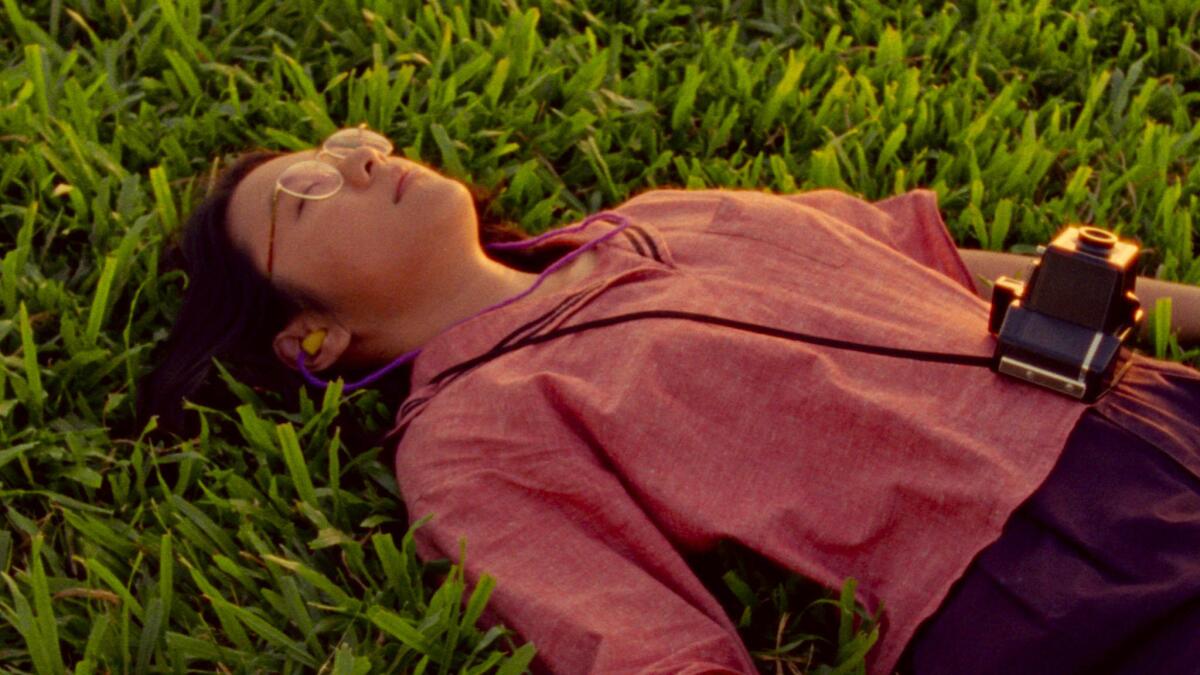Before she was so rudely interrupted: ‘Shirkers’ director Sandi Tan on realizing a dream deferred

- Share via
What happens to a dream deferred? Filmmaker Sandi Tan has had to grapple with that question for the last 25 years.
In 1992, the then-19-year-old made an ambitious and ultra-low budget road movie with friends Jasmine Ng and Sophie Siddique that seemed certain to become a cult classic in their native Singapore — if only because the country’s film production was essentially nonexistent. But then Georges Cardona, the mysterious, middle-aged American film teacher who was tasked with directing the project, vanished without a trace and took 70 canisters of film, boxes of scripts and storyboards with him.
“It was a slow drip, the realization,” Tan says of having the footage taken. “It just kills you slowly. It was months, maybe years before it dawned on us.
“It’s like we remembered what it was like to fly and now we have to walk forever,” she continues. “You are back to Earth, doomed to never speak of this because there’s no proof that it ever happened. There’s no proof you were ever special.”
The whole sordid story is the focus of “Shirkers,” a Netflix documentary that shares its name — and a significant amount of footage — with the would-be film. Tan’s doc is now streaming on the site and playing in limited theatrical release.
Cardona, an enigmatic figure with a passion for art cinema and a knack for tall tales, had befriended the group of teens only to snatch their dreams, and Tan ultimately discovered she wasn’t the only one this happened to.
“He was a great storyteller,” Tan says. “He was very, very talented. If he walked into the room right now, the promise of adventure when he talks to you is so intriguing and so seductive that ... you’d want to go off with [him].”
With hindsight 20/20 (and now that she’s been reunited with the lost footage in a surprising twist of fate), Tan is able to talk about the late Cardona without bitterness.
“People say I’m too kind to him,” she says. “I don’t think I am. He is not my villain, he is my nemesis and there is a difference. It strengthens me to consider myself his equal, therefore I’m not his victim. I think that’s the way you win over somebody like that.”
In the documentary, Tan uses the recovered footage to illustrate the backstory of “Shirkers” before switching gears to unfurl some of the yarns Cardona spun, involving both herself and other young people he took advantage of.
“It seemed like he would hijack the movie a second time because he’s so interesting,” she says. “But you could not possibly tell our story without telling his story.
“I think his story is so remarkably fascinating because he was very creative. But his way of creating was to create holes in people’s lives so he could be remembered.”

REVIEW: Sandi Tan’s ‘Shirkers’ is a captivating journey into a lost cinematic past
Tan knew for years that the story of “Shirkers” deserved to be told, but it wasn’t until she was reunited with the footage in 2012, the same year her novel “The Black Isle” was published, that she began formulating how to make it happen.
“It took me three years before I could open [the film canisters] and look at them,” she says. “They were like this vortex of something demonic sitting in my house. I knew the moment I opened them and dealt with them it would be a rabbit hole. And I’d be sucked into the underworld like ‘Alice in Wonderland’ again.”
She also knew it would be expensive to digitize the 700 minutes of 16-millimeter footage. But after sitting down with a technician in Burbank, she had her first moment of vindication.
“When I saw the footage I thought, ‘Oh, this is exactly as I remember it,’” she recalls. “It was exactly as shimmering and ambitious as it was in my head all those 20 years ago. And this stranger sitting next to me, who was used to working with amazing footage, his jaw dropped because he had never seen anything like it. And then once he knew the story, he said, ‘OK, wow. This is amazing. You’ve got to do something about it.’”
Persuading Ng and Siddique to participate was the hard part.
“Everybody was afraid of seeming silly that they were taken in [by Georges’ cons],” Tan says. “But when you show us as a whole, you realize nobody was silly because these were all intelligent people and we were all enthralled by Georges at one point in our lives.”
“It’s such a dark force that has bound us for decades, the three of us,” she adds. “But as Sophie says, it’s a double-edged sword because we have a bond unlike that we have with anyone else. It’s like having gone through a war together and now we’re all PTSD soldiers scattered around the world.”

The process of putting the documentary together was “extremely difficult,” Tan says. “Extremely, extremely difficult.”
“Nobody had any faith in me, really,” she says. “It was a huge battle for over three years.”
Working mostly without a producer, Tan struggled to procure the money needed to make the film.
“Getting funds was very difficult because it’s not a social-issue doc,” she says. “In America, those tend to get funding. If you’re an outlier or it’s a strange film, it’s just really hard. There’s basically two places that will give you little bits of money: Sundance Institute and Cinereach. And I got both.”
Despite the grants, finding people she could afford to work with remained challenging. “It turned out to be a blessing in disguise [though] because then I was forced to be resourceful in the way of the original ‘Shirkers,’” she says.
She hired a 27-year-old skateboarder named Lucas Celler as the editor and they worked on the film in her garage for eight months. “We grew together,” says Tan. “I really believe in having faith in people and everybody growing and stretching.”
The tight budget also forced her to work over Skype with Israel-based composer Ishai Adar and to begin brainstorming ideas with sound designer Lawrence Everson as early as a year before production began.
“You have to think ahead if you have no help and no support system,” she says. “You have to micromanage everything and to think of every aspect from start to finish. That’s the freedom of having no seasoned producer to tell you what to do.”
Despite the difficulties, Tan says she wasn’t discouraged by the doubts or lack of support.
“The nice thing about coming from a place where everybody is very negative is you really are not easily discouraged,” she says with a laugh. “I knew this was a good story. I knew I had great footage, I knew I had good interviews, I knew there was going to be a movie here that was going to be compelling. It was just finding my way there, solving this gigantic jigsaw puzzle was going to take time and effort.
“I love a challenge,” she adds. “I mean, how can you not find this fun? I just think this is the most fun thing in the world.”

Making this film was like rediscovering my confidence in my voice, my passion for making films in the 21st century.
— Sandi Tan
The original “Shirkers” was inspired heavily by Tan’s experience growing up in Singapore in the late 1980s and early ’90s.
“Growing up in Singapore, it’s such a prosaic, staid, boring, stultifying place,” she says. “Hidebound, full of rules, it’s pretty sterile. The tourist brochure version of the place is often the [only] version of the place [seen].
“The version of Singapore that I saw and loved and discovered on my own personal searching was so different from that that I wanted to have the film be a catalog of all these favorite places that I knew were going to disappear.”
Those places ran the gamut from mannequin shops, unfinished highways, railway tracks and back alleys. But she also wanted to catalog people.
“All these funny faces that I’ve encountered and thought, ‘You know, these people should be in the movies,’” Tan says. “Things move so quickly and change so quickly that you just want to crystallize everything to make it special.”
That desire to capture the ephemeral was inspired in part by J.D. Salinger’s “The Catcher in the Rye” which hugely influenced Tan’s script for the original “Shirkers” and its dreamy narrative about a young woman who goes around saving kids and killing adults.
“I just really identified with Holden Caulfield,” says Tan of the book’s protagonist. “I mean, everybody does, but specifically in the context of Singapore in the ’90s. It felt like the U.S. in the ’50s … there’s some correlation there of the world changing and watching your siblings and cousins growing up. These kids that are exceptional and precocious and really adorable and magical, they’re going to grow up into soulless individuals like everybody else. So you want to try to stop that or stem that flow.”
And while the original “Shirkers” is unlikely to ever be seen as it was intended, creating a documentary about the experience afforded Tan a second chance at exploring the filmmaking aspirations of her adolescence.
“Making this film was like rediscovering my confidence in my voice, my passion for making films in the 21st century, [and] knowing that you can use the same kind of DIY methods where you’re basically going it alone in your garage,” she says. “And I find that really exciting. It’s very empowering to realize that you’re not the sorcerer’s apprentice anymore, you’re the sorcerer.”
ALSO
The Writing Life: Sandi Tan switches genres for ‘The Black Isle’
Jamie Lee Curtis, Judy Greer and Andi Matichak discuss the ‘powerful’ climax of ‘Halloween’
Kevin Hart, Malcolm D. Lee and Will Packer on putting together a motley crew for ‘Night School’
follow me on twitter @sonaiyak
More to Read
Only good movies
Get the Indie Focus newsletter, Mark Olsen's weekly guide to the world of cinema.
You may occasionally receive promotional content from the Los Angeles Times.











